

|
Archive for September, 2007
Wednesday, September 26th, 2007
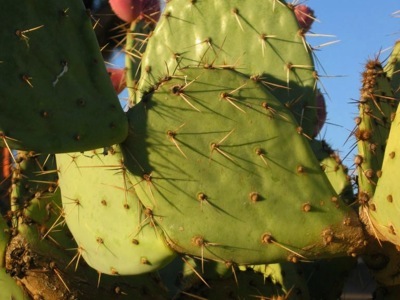
I’m at the Celiac Sprue Association national conference in Tucson, Arizona. Things will be in full swing tomorrow and I’ll keep you posted as to what’s going on. There are four days of great speakers scheduled; from Lee Tobin at the Whole Foods Gluten Free Bakehouse to Stefano Guandalini, gastronenterologist and international celiac specialist from the University of Chicago Hospital. Lifestyle changes, gluten free baking, what’s on the horizon, nutrition therapy, new products, updates on research, and on and on.
I’ll fill you in as long as I can manage my internet connection. It’s a bit sketchy at the place I’m staying. Otherwise I’ll put together a detailed blog entry when I return.
More later…
Melissa
Tuesday, September 25th, 2007
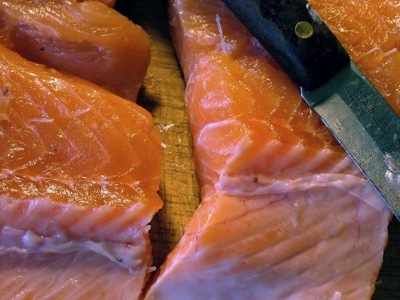
I love salmon. It’s high in omega-3 fatty acids, which are anti-inflammatory and also help protect against cardiovascular disease (among other things). Wild salmon is a better choice than the farmed versions for a variety of reasons (I’ll spare you the details and save it for later). According to the Marine Stewardship Council, wild-caught salmon from Alaska is the best choice as it is certified as sustainable. Market names for these choices are Coho, Sockeye, King, Pink and Red Salmon.
For more information on the importance of making sustainable seafood choices, check out the Monterey Bay Aquarium. You can also download pocket-sized regional Seafood Watch Guides to keep with you, so you don’t forget which are your best choices and which fish to avoid. For example, scientists agree that we are now fishing the last 10% of the Atlantic Cod population. Avoid Scrod, Whitefish and Atlantic Cod for that reason. Educate yourself so you can support sustainable options and avoid fish that are declining in numbers.
On to the recipe.
what you need
1 cup sake (Japanese rice wine)
1/2 cup gluten-free tamari
1 tablespoon fresh ginger
2 cloves garlic
1 tablespoon dark brown sugar
12-ounce salmon filet, cut in two 6-ounce pieces (or something similar)
preparation
preheat oven to 425
cover a cookie sheet with tin foil and oil slightly
what you do
1. mix first 5 ingredients together in small bowl; reserve 1/4 cup of the marinade for later
2. rinse salmon under cold water, pat dry with a paper towel and place in ceramic baking dish
3. pour marinade (remember to reserve 14 cup for later) over salmon
4. cover and put in refrigerator for 1 to 3 hours (occasionally spoon liquid over exposed parts of the fish)
5. place fish on prepared pan and put on middle rack in oven
bake for 10 to 12 minutes or until fish flakes easily with a fork (it depends on how thick your filets are, you may need less time; don’t overcook)
6. pour reserved marinade over fish and serve immediately
Serve with roasted Yukon Gold potatoes and a side salad. YUM!
In good health…
Melissa
Monday, September 24th, 2007

There are so many naturally gluten-free and healthy food options that it really doesn’t have to be that hard to eat wonderful and nourishing meals if you have celiac disease. And while I’m on the subject, I intensely dislike the word disease in connection with celiac.
Condition, circumstance, situation – there has to be a better word than disease. Can anyone come up with one? Something a little more uplifting and positive. If you were never exposed to gluten (ever), you would never end up with celiac disease (ever), so let’s call it something else. I think I’ll start calling it the “celiac phenomenon.” Or as my son’s girlfriend says, “that yak thing.” Give it some thought. We need a new name for this, something more optimistic.
Okay, back to taking charge of your gluten free lifestyle and making it a nourishing and savory one. Nourishing, savory, and gluten-free go together quite well. It does take some time and effort though.
No time? Yea, I know, it’s not easy, but once you get in the swing of things, it’s not that bad. And it’s actually a lot of fun, but you do have to do your share of of up-front work to stay off the nutritional slip and slide. Prepare things ahead so you don’t get stuck munching on less healthy choices out of desperation. Like a bag of potato chips or gluten-free, prepackaged cup cakes. You’ve heard this before, but just because it says gluten-free doesn’t mean it’s healthy.
This spinach salad takes very little time to prepare, is a nice change from typical dinner salads, and is packed with high-end nutrients. Add some wild rice on the side and you have a whole meal.
what you need
2 tablespoons water
1 and 1/2 tablespoons red-wine vinegar
1 tablespoon olive oil
1 tablespoon agave honey (or any other honey)
2 teaspoons dijon mustard*
1/4th teaspoon ground black pepper
2 Bosc or Anjou pears (cut lengthwise into slices)
several cups of torn spinach (flat leaf or baby spinach works best)
1/4 cup thinly sliced red onion
1/4 cup pecans
what you do
•combine first six ingredients in a small bowl; stir well with a whisk
•place pear slices in the bowl with dressing; toss to coat and let sit in refrigerator for an hour or so (if you don’t have time to let the pears marinate, it doesn’t matter)
•put spinach in serving bowl (I like using a pie pan size dish, something not so deep)
•add pears and dressing
•add onion slices
•lightly toss to coat spinach
•sprinkle with pecans
* I like Annie’s Natural Dijon Mustard (gluten-free)
Yum!
the nutritional profile of spinach (it’s good stuff)
I’ll start with the over-the-top nutritional values provided by this Popeye-sustaining vegetable. First off, one cup of fresh spinach provides a whopping 1110% (no mistake, that’s thousand) of the daily value of vitamin K, 294% of vitamin A, 84% of manganese, 65% of folate and 35% of iron. It also has plenty of vitamin C, B2, calcium, potassium, B6, dietary fiber, protein and on and on. Even some omega 3 fatty acids. This is all packed into one cup of spinach, which is a measly 41 calories. Lots of bang for your buck!
In good health…
Melissa
Friday, September 21st, 2007
This post will be the art of aging, part 1. Part 2 will follow at a later date. I need to get older to do part 2.
The good, the bad, and the ugly truth about aging and how to avoid acting your age as you rack up those birthdays.
When we hear the word aging, we automatically think of older people, but the truth is, we start aging at birth when we choke, sputter, and take our first screeching breath announcing our arrival to the world. Functional and structural changes occur in the body throughout life, but once maturity is reached at age 20 to 25 years, growth stops and by around age 30, age-related changes can become noticeable. Can become noticeable, but many of these changes aren’t inevitable. Let’s start with the cold, hard facts (the bad and the ugly) . . .
Changes in body composition occur. Lean muscle tissue decreases and body fat increases. Research indicates that beginning at age 30 we can expect a loss of about a half-pound of muscle tissue per year. As this ratio changes, metabolic rate falls.
Decreases in strength and power occur. With the loss of lean muscle tissue comes a decline in the functional structure of the muscle which translates to less strength, less power, and a longer response time.
Flexibility is reduced. Tendons, ligaments, and cartilage become stiffer and more rigid with age and more prone to injury.
Cardiac function is reduced. Heart muscle strength begins to decline as we age, and with it, pumping power. Arteriosclerosis (hardening of the arteries) and increases in blood pressure also make it difficult for the heart to function properly.
Aerobic capacity declines. Simply put, this means it becomes more difficult for the heart and circulatory system to transport the oxygen the body needs to exercise.
Yada, yada, yada. Okay, we get it. So, now who says we have to follow those rules? Well, the truth is, we don’t.
Now the good news. Although a reduction in muscle mass and an increase in fat tissue is the norm with aging, it’s not inevitable. It takes some effort, but with regular exercise, some type of strength training, yoga, and by controlling energy intake (it’s that calories in/calories out thing) and eating the right kinds of foods, older athletes can maintain the same body-fat ratios as younger athletes. Studies show that people who engage in resistance training can increase their lean body mass component and decrease body fat. It’s even possible to gain muscle mass with increasing age. I’m not all that into the gym scene, but a good vinyasa yoga class with some arm balances and inversions can accomplish the same thing. It really doesn’t matter, just get up and move. Dance, walk the dog, do cartwheels, play tennis, stay active.
Along with maintaining lean muscle tissue, strength training also increases muscular strength and power, no matter what your age. In fact, the results of one study showed that untrained men ages 60 to 72 were able to increase quadriceps strength by over 100 percent and hamstring strength by over 200 percent — all in just 12 weeks of resistance training. Strength training has also been indicated to help protect against osteoporosis. Good, good. Do pushups. Use jugs of laundry detergent for weights, you don’t have to make this complicated.
Flexibility can be maintained or increased at any time of life. Being aware of proper hydration and participating in a flexibility program can help prevent injuries, and protect joints, muscles, and connective tissue. Yoga and Tai Chi are great choices no matter what your age. An added benefit is increased balance, grace, and coordination. Yoga, yoga, yoga. That’s my mantra. And I’m a true believer that balance is a great indicator of overall health. It’s one of those things you can easily work on and increase whether you’re 10, 20, or 100 years old. It doesn’t matter, you can enhance balance at any age. (I plan to do a complete post on balance one of these days, that’s how important I believe it is to optimal well-being.)
Cardiac health can be enhanced and functional losses reduced with proper training and nutrition as well. Many of the cardiovascular changes that take place as we age are the result of lack of use and poor lifestyle choices rather than aging. Regular aerobic exercise, a healthy diet, eliminating stress, and getting quality sleep (that can be a tough one), can minimize or even reverse cardiovascular declines. Although aerobic capacity tends to decline with age, this doesn’t have to be the norm.
Make up your own rules! What you eat, think, and do will reflect in how you age. Emotions and attitudes about aging are just as important as physical activity. And don’t forget the sense of humor!
In good health!
Melissa
Thursday, September 20th, 2007
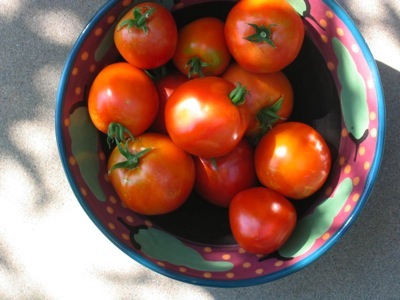
So, what’s with that saying? Who says tomahto, anyway? No one I know.
Those of you with upper-crust, Ivy League educations maybe. You know who you are. You’re the ones who probably say tomahto. Well, do you know what the Tariff Act of 1883 was? Hmm? Do you? Are there any agricultural history buffs out there reading this blog?
Okay, Jon or Cindy, it falls on you to answer this one. Not exactly particle physics or nuclear fission or whatever it is you two are into, but since you’re the only ones reading this blog, it’s up to you. Or Tevis, who has a master’s in gothic literature or some obscure thing like that. At least I’m attracting an interesting cast of characters. Although Tevis’ interest is by default since we’re genetically linked by DQ2 (that “special” gene that predisposes one to celiac disease).
I’m rambling, sorry about that. Back to 1883, when Congress decided to pass a rather innocuous law requiring a 10% tax on imported vegetables, but not on fruit. Along comes New Jersey importer, John Nix, who refused to pay the import tariff on his tomatoes, arguing that technically they were fruit. And he was right, in a botanical sense. This paramount case ended up going all the way to the Supreme Court (don’t they have better things to figure out) and the Court justices all agree that commonly tomatoes were vegetables and therefore subject to the same tariff as other vegetables. “Commonly” was the deciding factor, although “botanically” tomatoes are of the fruit family.
And so it goes, the United States Supreme Court ruled that legally, a tomato is a vegetable even if it is a fruit. One hundred and twenty years later, our courts were still deciding monumental cases such as the vegetable vs. fruit case of 1883. In 2003 the United States Court of International Trade made a tariff determination between two types of action figures. Are they dolls or toys? Fruits or vegetables?
Tariffs are higher for dolls than for toys. Geez, what’s the difference? Isn’t a doll a toy? Whoa, and what about those mutant super heroes? Are they dolls or toys? Or action figures? Or real people? Yikes, it sure gets confusing when lawyers get involved.
But I digress.
As one of my favorite yoga instructors in the world always says (yes, that’s you Scott), “my point is (and I do have one),” tomatoes are high in nutritional value and a great way to add some color into your diet. Color is good. The more vibrant, the better.
Tomatoes are rather trendy right now. Research on phytonutrients (plant nutrients) has shown that lycopene, an antioxidant found in tomatoes, helps prevent heart disease and some forms of cancer.
Lycopene is a carotenoid and studies show higher concentrations are found in organic tomatoes than in their conventional counterparts.
In fact, according to the folks at the USDA Agricultural Research Service, organic brands of ketchup also contained much higher levels of lycopene. The darker the red color, the higher the nutritional value. One brand of organic ketchup they studied (I don’t know which one) contained 183 micrograms of lycopene per gram of ketchup, which is about five times as much per weight as a tomato. One of the fast-food packets of ketchup contained 1/3rd the lycopene as the organic brand. But then again, any food you receive through the window of your car is probably not the best choice.
And as always, whole tomatoes trump ketchup (even organic ketchup) in overall nutritional value. Plus, most ketchup is high in sugar, so go easy on the condiments. I occasionally use Annie’s Naturals organic ketchup (I love ketchup on scrambled eggs). Annie’s is gluten free and dark red in color, so if you can, go for the good stuff. The darker the red, the better.
Back to tomatoes. Boy, I’m spiraling today; from mutant action figures to ketchup.
I’ll try to sum this up. Tomatoes (lycopene) may help reduce the risk of prostate cancer and may also lower the risk of colon cancer. They are also an excellent source of vitamin C, vitamin A, vitamin K, and are a good source of fiber, potassium, folate, manganese, B vitamins, vitamin E, and they even contain some protein. Good stuff, these tomaytoes!
In good health!
Melissa
P.S. These yummy looking tomaytoes in the photo are right out of my generous neighbor’s garden. The best of the best! Thanks Ron!
Wednesday, September 19th, 2007
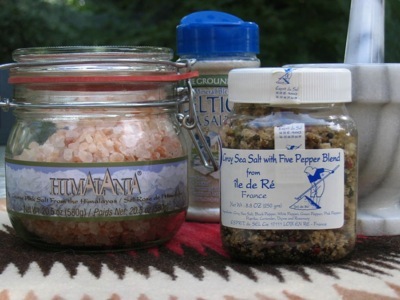
Posting an entire segment on salt may seem a touch strange, but I’m curious about all the flavoring additions to cooking and baking and salt is one of the most important ones for seasoning foods. As a food preservative, it played a contributing role in the development of civilization and was a very precious commodity. History even suggests that Roman soldiers were paid with salt. The term salary derives from the Latin word sal or salarium, hich translates to salt. Wars were fought over salt. Weren’t they? Wasn’t there the War of Salt, or the Seven Year Salt War? Maybe not, but it was definitely an important part of early trade and commerce. It’s even mentioned several times in the Bible. Don’t ask me where.
Back to the basics. Salt draws moisture out of food so bacteria can’t grow, hence it’s evolvement as a food preservative. Today it’s used heavily in processed foods; it adds flavor, reduces dryness in crackers and snack foods, increases sweetness in cookies and cakes, and even helps mask the chemical and metallic aftertaste in canned sodas and soft drinks. Yuck. Most people get more than the recommended 1,500 to 2,000 milligrams of sodium per day because of the amount of processed foods they eat. As always, minimize processed and refined foods and go for whole, nutrient-dense choices instead.
Sea salt and salt mined from the earth are harvested from the ocean or remnants of ancient oceans and salt lakes. These versions are evaporated and sun-dried and contain trace elements that are missing from fully refined or chemically manipulated table salt, but also don’t contain the iodine levels that are added to table salt. Sodium (the primary constituent of salt; either version), is one of the electrolyte minerals we need for normal cell function. But we’ve all heard that overuse of salt can cause kidney problems and high blood pressure, so balance and moderation are important.
I prefer Celtic Sea Salt as it has a mellow taste and is more flavorful than commercial salt, which tastes a bit “chemically” to me by comparison. I also much prefer the texture of sea salt. The fact that it is hand-harvested and solar evaporated (sun dried) using traditional methods is appealing to me as well. This has been the process for thousands of years. But spending the extra money for sea salt doesn’t necessarily guarantee you’re getting a better product. It does take some effort to figure all this out, but from what I’ve learned, Celtic Sea Salt is harvested by salt farmers (paludiers) in one of the most pristine coastal regions of France. It contains trace elements that are refined out of table salt and the company states that they also test for heavy metals which can be a problem with some sea salts depending on the area where the salt is harvested. Celtic Sea Salt lab results (under FAO/WHO Codex standards) state there were no detectable levels of arsenic, cadmium, or mercury in their products, which is definitely a good thing.
Whichever salt you use to season your food, use in moderation and try adding various herbs and spices to enhance flavors. Be creative and have fun playing with your food!
Tuesday, September 18th, 2007
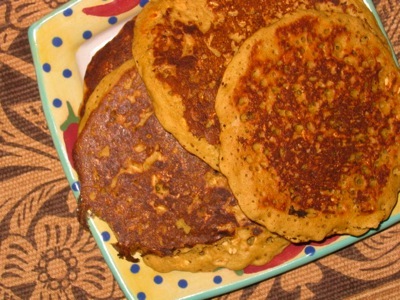
I go back and forth about oats, but I’ve been giving Bob’s Red Mill Gluten Free Oats (whole grain rolled oats) a try. This is my second attempt at eating oats and these pancakes didn’t bother me at all, but the oats didn’t amount to much.
On my prior post on oats, I gave you the current thoughts on adding them into your diet if you have celiac disease. There is some controversy surrounding oats, but most experts feel gluten-free, uncontaminated oats are safe for people with celiac disease. They should be introduced slowly, in small doses, and need to be from an uncontaminated source. This recipe, which I adapted from one on the Ancient Harvest organic quinoa flour package, only has 1/3 cup of oats spread out among 7 or 8 pancakes, so in reality, I probably ate a tablespoon’s worth. Maybe less. No repercussions and it was a treat to have hearty pancakes. You could easily adjust the recipe to skip the oats.
Before I post the instructions, I’ll give you a run-down of the nutritional “oomph” of quinoa. Good, good stuff. The Incas referred to quinoa (pronounced keen-wah) as “chisaya mama” or the “mother of all grains” because of its ability to keep their armies strong. They considered it a sacred food and were on the right track. Quinoa is a power-packed, complete protein – balanced with all the essential amino acids we can’t make on our own and higher in quality protein than any other grain. It will definitely give you a boost in power yoga and is perfect for healing sore muscles after a day of hiking or skiing. Quinoa is also loaded with fiber and is high in vitamin E, iron, zinc, phosphorus, calcium, and magnesium. It has a slightly sweet and nutty taste and is botanically similar to Swiss chard and beets rather than being a true grain. Both the whole grain and the flour are nice additions to your gluten-free pantry.
quinoa oat cakes
what you need
1/3 cup quinoa flour
1/3 cup sorghum flour
1/3 cup GF rolled oats
1/2 teaspoon aluminum free baking soda
1/2 teaspoon salt
1 teaspoon cinnamon
3/4 cup rice milk (or whatever variation you want)
2 tablespoons grapeseed oil
1 teaspoon vanilla
1 tablespoon agave honey
1 egg
what you do
• whisk together dry ingredients in medium sized bowl
• stir milk, slightly beaten egg, oil, and honey together
• add liquid ingredients to dry ingredients and blend
• pour about 1/2 cup batter onto prepared griddle
• flip pancakes when they are puffed and full of bubbles and the edges turn under, but before bubbles break
Enjoy!
P.S. As soon as I make and get a picture of my quinoa tostadas, I’ll post that as well. Quinoa and amaranth are two of my favorite flours and grains to cook/bake with.
Monday, September 17th, 2007
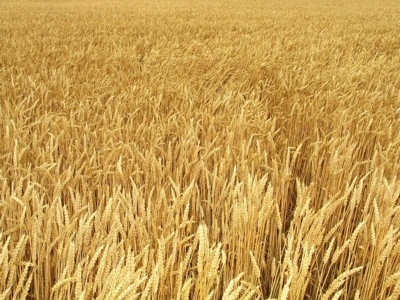
Wheat may be the “staff of life” for some, but it’s the “kiss of death” for those of us with celiac disease. And once you start trying to avoid it, you realize it’s everywhere. EVERYWHERE!
According to Wikipedia, the free online encyclopedia, “In 1997, global per capita wheat consumption was 101 kg, with the highest per capita consumption (623 kg) found in Denmark.” Can that be right? Per capita (everyone on the planet) consumes an average of 222 pounds of wheat per year? How can that be? I suppose if you eat a bowl of Wheaties every morning, then have a couple of donuts during your morning break, follow it up with a sandwich at lunch, a handful of cookies in the afternoon, and a plate of pasta for dinner, you could rack up those kilograms fairly quickly. But my gosh, 222 pounds per person per year! And what’s with the Danes?
In 2005 (again, according to Wikipedia), annual wheat production was 626 million metric tons. MILLION! Since I haven’t eaten wheat for years and spend a good deal of my time trying to avoid it, I’m having some trouble processing these numbers. And if global consumption is per capita, who’s eating my 222 pounds? The same thing probably applies to most of you reading this blog since it is called glutenfreeforgood. Who’s eating your portion?
Now, let’s consider how much gluten is too much if you have celiac disease. Sometimes it’s either impossible to avoid, or you decide you just plain can’t live without that piece of birthday cake. Research indicates that ingesting 100 milligrams of gluten a day will continue to cause intestinal damage in people with celiac disease. Studies from Finland suggest the “safe” amount that may be consumed per day to be around 30 milligrams. How much is 30 milligrams you ask? Less than ONE teaspoon of that birthday cake you’ve been coveting! To put this in perspective, one sandwich contains about 3000 to 4000 milligrams of gluten. (Peter HR Green; Celiac Disease: A Hidden Epidemic; HarperCollins 2006).
Wow, I wonder how many milligrams of gluten are in that 222 pounds of wheat eaten per capita each year?
Having said all that, aren’t we lucky to have this wonderful abundance of “alternative” grains to experiment with? I made quinoa tostadas topped with chicken and veggie salad last night for dinner. It was wonderful, much better than any wheat or corn tostada I’ve ever had. Plus, quinoa is incredibly healthy, much higher in nutritional value than wheat.
No wheat? No worries. Sort of anyway.
In good health,
Melissa
Sunday, September 16th, 2007
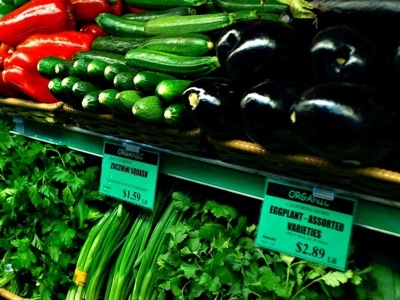
Before I launch into my post for today, I want to let you know that I’m aware of the computer glitches that are occurring on my site and am in the process of figuring all that out. I have a Mac and am using Apple software to create the website and blog myself and apparently things don’t look quite the same on a PC (pictures may be missing, the formating is off, etc.). I’m also aware, thanks to two sweet, friendly, and experienced GF bloggers (Cindy at Cindalou’s Kitchen Blues and Seamaiden at Book of Yum), that the URL situation I’m dealing with isn’t working that great either. So please hang in there with me and I’ll keep posting recipes, nutritional information, and health tips while ironing out my technical difficulties. HELP!
Okay, back to the point of all this, which is to share in a healthy, nutritious, active, and fun gluten-free lifestyle. Like the Beatles so aptly sang, I get by with a little help from my friends. Going to try with a little help from my friends.
Don’t we all need a little help from time to time? And part of “getting by” on this GF journey is sharing ideas, recipes, survival tips, humor, and creativity with each other. This is a wonderful little subculture; a cyber community that links us all together, even if we’ve never “officially” met. I love it!
Onward . . .
Organic. Is it worth the money? I briefly touched on this a couple of days ago in my “lots about lettuce” post, which (drats) was missing the second picture if you viewed the post from a PC. I’m a fan of organic food and from what I’ve read, most of the time there is a difference in the nutritional value, not to mention the avoidance of pesticides and the effect on the environment. A National Academy of Sciences study stated that, “Low level pesticide exposure can cause serious, developmental risks to infants and children, some with lifelong consequences.” Also, for those of us dealing with digestive conditions such as celiac disease, avoiding pesticide exposure whenever possible is a good thing; less junk for our hard-working livers to deal with. At least try to minimize exposure by choosing organic when purchasing the following fruits and vegetables (the first list below). These have been labeled the “Dirty Dozen” by the Environmental Working Group after running over 50,000 tests for pesticides on produce collected between 2000 and 2005. If you can’t opt for organic in all your food choices, try to make your conventional choices from the “Cleanest 12” and your organic choices from the “Dirty Dozen” list.
The Dirty Dozen (highest in pesticide residue in order as listed)
peaches
apples
sweet bell peppers
celery
nectarines
strawberries
cherries
lettuce
imported grapes
pears
spinach
potatoes
The Cleanest 12 (lowest in pesticides)
onions
avocados
sweet corn (frozen)
pineapples
mango
sweet peas (frozen)
asparagus
kiwi
bananas
cabbage
broccoli
eggplant
Get the full list of results at www.foodnews.org.
Here’s to good health!
Melissa
Friday, September 14th, 2007
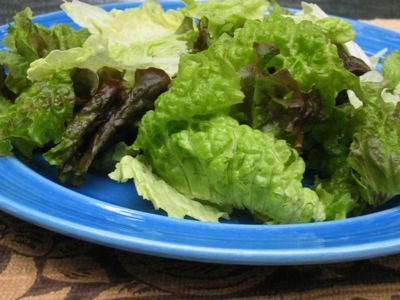
I eat a big salad almost every day during the summer. Salads make a great meal when you crave something light, yet healthy and filling. “Light” and “filling” can go together and a salad can be served for breakfast, lunch, or dinner; it doesn’t matter. Who decided breakfast was pancakes, lunch a sandwich, and dinner pizza, anyway? Obviously not someone with celiac or a gluten intolerance. *See the final version and my favorite salad dressing recipe below.
Why dedicate an entire blog entry to lettuce, you ask? What’s there to say? Other than it makes for good rabbit food. Lots!
First off, I get my lettuce from a wonderful local organic source called Grant Family Farms. The Grant family has been growing organic vegetables for the past 25 years and were the first to be certified organic in the state of Colorado. They’re also a CSA designated system, of which I plan to apply to be part of for the next growing season. Right now I’m getting Grant Farms produce at my local health food market.
What is CSA? “A CSA is an innovative and resourceful strategy to create a straightforward partnership that brings together community members, farmers and agricultural land into a relationship of support. The CSA system provides a direct link and responsible relationship between people and the food they eat, the land upon which it is grown and those who grow it. Based on an annual commitment to one another, community members provide a pre-season payment to purchase a “share” of the season’s harvest. The member then receives a weekly box of a wide variety of fresh produce through the growing season, harvested at the peak of ripeness and flavor.” Grant Family Farm website.
lettuce
the basics
The scientific name for lettuce is Lactuca sativa, which is derived from the Latin word, lactuca, which means milk. When you break apart a piece of lettuce from most varieties, a slightly bitter, milky substance is released, hence the name. The variety in the photo I took above is “loose leaf” lettuce. It is the best known version and includes green and red leaf lettuce. I also have a little Chinese cabbage thrown in to the mix (the very light colored leaves). That makes for a good blend of nutrients to start from. That was my launching pad, see final product below.
nutritional profile
In general, the darker the leaves, the higher the nutritional content. Iceberg is the lowest on the totem pole. Reach for the dark green and red varieties. Romaine and loose leaf provide LOTS of vitamin K, vitamin A, vitamin C, folate, manganese, chromium, potassium, and fiber. They also carry a good share of thiamin (vitamin B1), iron, riboflavin (vitamin B2), phosphorus, and calcium. And a decent amount of protein (surprise), omega 3s (surprise again), tryptophan, niacin (vitamin B3), and pyridoxine (vitamin B6). And all for a measly 15 calories for 2 cups. Wow, you just can’t go wrong with a good heaping plate of lettuce. Of course you need to top it with all sorts of good things; the more diverse the better. No need to stick with plain old tomatoes and carrots. Not that you shouldn’t include those, but be daring and try whatever you have around. Plums, pineapple, shredded raw beets, shredded raw squash, dates, seeds, nuts, cooked rice, jicama, avocado, cranberries, cabbage, apples; whatever comes to mind. Pile it on!
is organic better
Choose organic when it comes to lettuce. It’s on the Environmental Working Groups list of the “Dirty Dozen” fruits and vegetables. YIKES! Lettuce came up with all kinds of nasty numbers. Check out the Complete Data Set of rankings from worst to best. Maybe lettuce should be one of your organic choices.
This is the “after” photo of my lettuce launching pad. The dressing is one I made up and my absolute favorite. And it works on everything and is healthy! Yippee!

Melissa’s GF salad dressing
what you need
• 2 tablespoons extra light olive oil
• 1 tablespoon apple cider vinegar (I use Bragg’s raw, unfiltered apple cider vinegar)
• 2 tablespoons Annie’s Naturals organic Dijon Mustard (contains white vinegar made from corn)
• 2 tablespoons agave honey (I use Madhava raw organic agave nectar)
what you do
put all ingredients in a small jar and shake well; refrigerate and use as needed; it’s yummy and it’s SO easy
Enjoy in good health!
Disclaimer: All material on this website is provided for informational and educational use only and
should not be used for diagnostic purposes. Consult with your physician regarding any health or medical concerns you may have.
|
|
|















